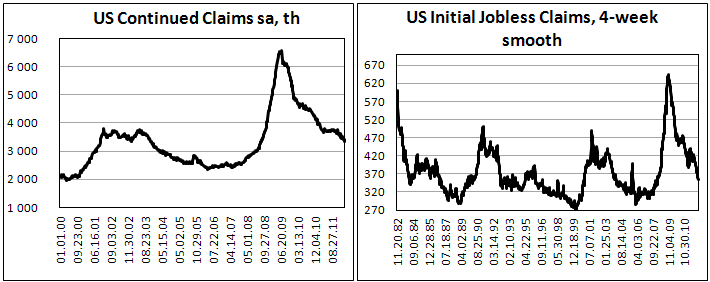EUR/usd
Improvement in macroeconomic indicators does not always imply the recovery of the whole economy. Sometimes other factors come into play and distort the picture. That was the case with yesterday's labour costs data in the euro area. The indicator showed a rather unexpected acceleration of the annual growth rate up to 2.8% in the last quarter of the previous year (when the economy declined by 0.3%). Meanwhile the analysts had quite reasonably expected it to slow down to 2.3%. The data on the employment change didn't point out any positive changes either. Over the last quarter of the previous year employment fell by 0.2% quarterly and annually. So, why do employers all of a sudden pay more in the time of the economic downturn and job cuts? The answer is simple – the governments are raising taxes, thus forcing companies to make bigger tax deductions. Thus, the recent figures hardly indicate any improvement or possibility of the further inflation speed-up. It's also very important to note that such distortions are likely to persist in the coming quarters, as most European countries have just stepped into the process of austerity implementation. Yet, improvements in the US are also hard to discern. The number of continuing claims is rapidly decreasing. Yesterday's weekly data indicated the drop of the figure down to 3.343 million, which is the lowest level since August 2008. But this progress is partly explained by the fact that the period, when people could claim unemployment benefits, has expired. Here it is also possible to include those who have lost hope to find a new job and abandoned their attempts. For comparison, with the similar number of unemployed claimants now and in summer 2008, the current unemployment rate in the US is at 8.3% against 6.1% then, and the economically active population totals 63.9% against 66.1%. Thus, the Fed looks more sensible than the markets, being careful and admitting the possibility of further measures to support the economy. To realize that too markets will probably need a month or two.

GBP/USD
Yesterday didn't abound in statistics on the UK, but that vacuum in the agenda was filled with various interesting speeches. MPC's Ben Broadbent noted in his speech that though the recovery from financial crises is usually slow, the household over-indebtedness in Britain shouldn't be so much fussed over. The current weakness can be accounted for by the previous rapid growth, which actually shows approximately the same result all in all. From his point of view, the health of the banking sector, which has been actively buying foreign assets, is of greater importance now. It seems as though the households had caused less harm to the country than the banks. But exactly the households have to pay for the inflicted damage now. In its turn, business attacked the government, blaming it for the highly uncertain prospects for the future, which do not allow companies to make their investment plans. “We do not have a single plan for growth. We have one every other week”, says British Airways chief Willie Walsh. In addition, the British business bitterly notes that Germany spends on research twice as much as Britain. Such self-criticism is really praiseworthy, that's already half the work.

USD/JPY
Stronger demand for risky assets on Thursday suspended the USD/JPY growth. After an impressive rally in the previous days and weeks the yen keeps staying away from the market movement today. Since the beginning of February the pair has grown by 10%. So now the yen will probably take a break and stop falling, while trading will turn into the sideways one. Earlier, from November 2010 to July 2011, the pair was holding in the 80-85 range. If it persists within these levels until summer, this, as so much awaited by the Central Bank, may really spur inflation in the country. However, stronger movements in such a relatively short time may prove undesirable.

AUD/USD
Some commentators point at the possible explosion of the housing bubble in Australia shortly. For now this process is under way in Brisbane and Perth, while the largest cities like Sydney and Melbourne still look stable with regard to the issue. Remember that during the financial crisis Australian housing prices, as well as the country's housing loans, were almost unaffected, thus putting no additional pressure on the economy during the global recession. At that time the conservatism of the Australian banks did them credit: they were not over-involved in the U.S. sub-prime mortgages and, therefore, didn't have to reduce lending for external reasons. But now it can be in a completely different phase –housing demand may be going down because of no progress in the labour market and slowdown in the export growth.
